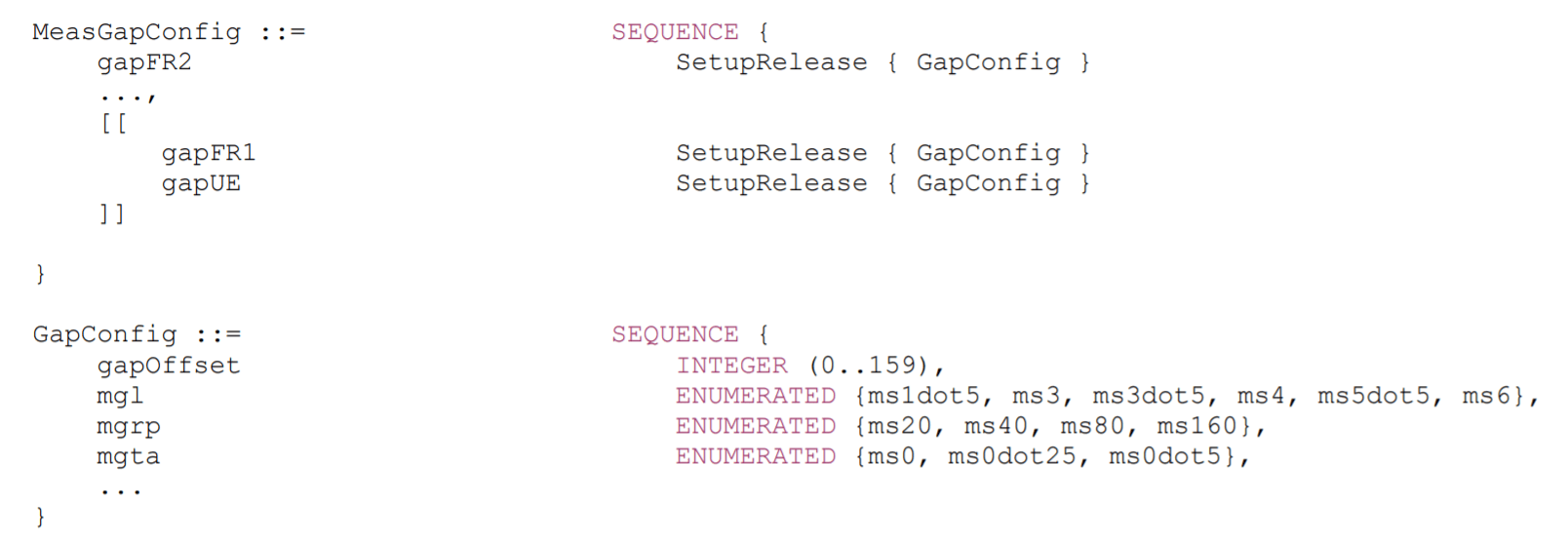5G NR Measurement Gap Configuration
A Mobile device has to measure the neighboring cells signal and other carrier components. Having a single RF module to control the Mobile manufacturing cost and form factor, device has to perform all this measurements, Transmission and reception of data using single RF module.
Mobile can measurement the neighbor signal transmitting on the same frequency very easy while simultaneously transmitting and receiving data from the serving cell. While for measuring cell operating at different frequency (Inter frequency Neighbors) and Other RAT (LTE is other RAT for 5G NR) mobile has to suspended communication (Tx/Rx) with serving cell and needs to tune RF module to configured frequencies (configured Meas Objects) and resume connection with serving cell after some duration.
The time duration during which mobile suspends it communication with serving cell to measure inter frequency neighbor or other RAT neighbor is known as Measurement Gap (Meas Gap).
Meas Gap Configuration
- LTE
- In LTE system , the Meas Gap Length (MGL) is fixed, such that at least one Sync Signals (PSS, SSS) is included within one gap. LTE Sync Signals are transmitted at 5 ms periodicity, so the MGL of LTE is 6 ms, allowing 0.5 ms for RF module re-tuning at the beginning and end of the Meas Gap. Terminals detect the Sync Signal within the Meas Gap, identify the Physical Cell ID (PCI) and reception timing, and there after terminals perform measurements with Cell specific Reference Signals (CRS).
- New Radio
- Meas Gap Lengths (MGL): 1.5 ms, 3 ms, 3.5 ms, 4 ms, 5.5 ms and 6 ms
- Meas Gap Repetition Period (MGRP): 20 ms, 40 ms, 80 ms and 160 ms
Different Types of Meas Gap in 5G NR
In 5G NR, there are following three different Meas Gap configuration –
-
- gapFR1: This meas gap configuration can only be applied to FR1. gapFR1 Geas Gap can not be configured together with gapUE. e.g. When UE is in RRC connected mode state with EN-DC attach and FR1 frequency needs to measure then gNB will configure either gapFR1 or gapUE.
- gapFR2: This meas gap configuration can only be applied to FR2. Similar to gapFR1, gapFR2 can not be configured together with gapUE. e.g. If UE is in RRC connected mode with EN-DC attach and FR2 need to measure then gNB will configure either gapFR2 or gapUE
- gapUE: This meas gap configuration can be applies to all frequencies i.e. FR1 and FR2. If gapUE is configured, then neither gapFR1 nor gapFR2 can be configured. With this meas gap configuration, UE can measure FR1, FR2 and non NR RAT.
Meas Gap Parameter Configuration
Similar to LTE, in 5G NR also RRC is responsible for providing measurement gap pattern configuration to UE. This is done using MeasGapConfig IE within the MeasConfig IE and is carried by RRC Reconfiguration message. It has two part, first part specifies control setup/release of meas gap and second part specifies measurement gap configuration and controls setup/release. The details of this IE as follows:

- gapOffset: It can be defined as the offset of the gap pattern. There about 160 offset values, but all values are not applicable for all periodicity. The offset values points to the starting subframe within the period, its value range is from 0 to MGRP-1. For example, if the periodicity is 20 ms, the offset ranges from 0 to 19
- Measurement Gap Length (mgl) : It is the length of measurement gap in ms. Measurement gap lengths can 1.5, 3, 3.5, 4, 5.5, and 6 ms.
- Measurement Gap Repetition Period (mgrp): It defines the periodicity (in ms) at which measurement gap repeats. It can be configured as 20, 40, 80, and 160 ms.
- Measurement Gap Timing Advance (Mgta): If this is configured, the UE starts the measurement mgta ms before the gap subframe occurrence i.e., the measurement gap starts at timemgta ms advanced to the end of the latest subframe occurring immediately before the measurement gap. The amount of timing advance can be 0.25 ms (FR2) or 0.5 ms (FR1).
Why Multiple Meas Gap
As indicated, 5G NR Meas Gap Length is not fixed and 3GPP specifications made it configurable. By having a fixed Meas Gap could cause unnecessarily degradation of throughput in the serving cell. The SMTC window and window duration can be set to match SSB transmissions and accordingly the MGL . For example, if we consider SMTC window duration as 2 ms and the Meas Gap Length as 6 ms, here 4 ms segment would not be available for transmission and reception of data in the serving cell will result in low DL/UL throughput.
To reduce such unnecessary degradation of throughput, NR specifications has introduced configurable Meas Gap Length to 5.5 ms, 4 ms, 3.5 ms, 3 ms, or 1.5 ms along with the legacy 6ms MGL.
This can be seen in case#1 and case#2. In Case#1 uses an SMTC window of 2 ms and gap with MGL of 4 ms, while Case#2 uses a 4 ms SMTC window and longer 6 ms MGL.

Meas Gap SFN and SF Calculation
Meas Gaps start during radio frames and subframes which satisfy the following criteria:
- SFN mod (MGRP/10) = FLOOR (gapOffset/10)
- Subframe = gapOffset mod10
Where, MGRP is the Measurement Gap Repetition Period, and gapOffset can be configured with a value between 0 and MGRP-1.
For example, when the MGRP is configured with a value of 40 ms and gapOffset is configured with a value of 35 then Measurement Gaps SFN and SF can be calculated as follows considering above equations.
- SFN mod (MGRP/10) = FLOOR (gapOffset/10)
- 1 mod(40/10)= FLOOR (35/10)
- 1 mod 4 = 3 False
- 3 mode 4 = 3 True
- 7 mod 4 =3 True
- 11 mod 4 = 3 True
- Subframe = gapOffset mod10
- Subframe= 35 mod 10
- Subframe =5
So the SFN for Meas GAP can be 3, 7, 11, 15, 19 etc starting subframe 5 during meas length period of 4ms as shown below.

Related Posts:
- 5G NR RRM Measurement Requirements
- 5G NR Measurement – Serving Cell and Neighbor Cell
- 5G NR Measurement Events
Reference:
- 3GPP TS 38.133 NR; Requirements for support of radio resource management
- 3GPP 38.331, NR; Radio Resource Control (RRC); Protocol specification
- 3GPP 38.321, NR; Medium Access Control (MAC) protocol specification



